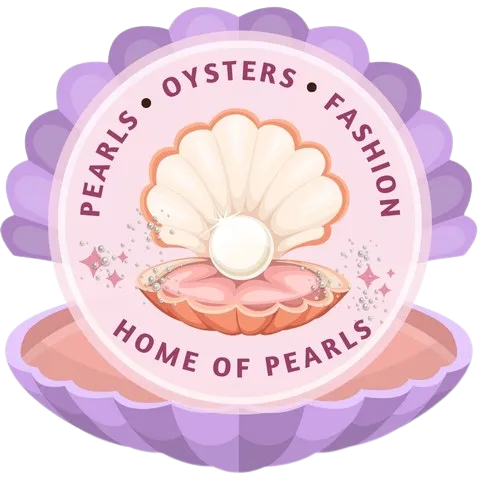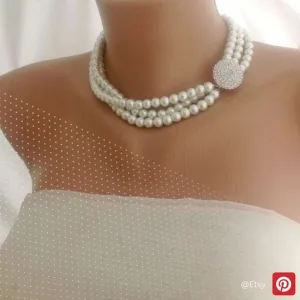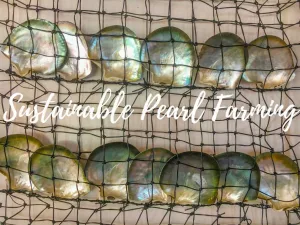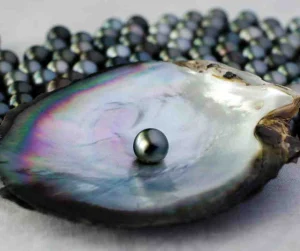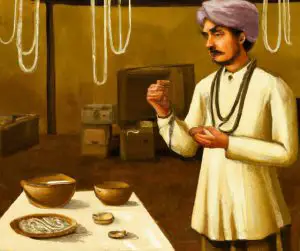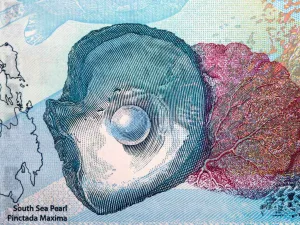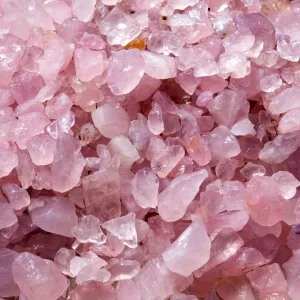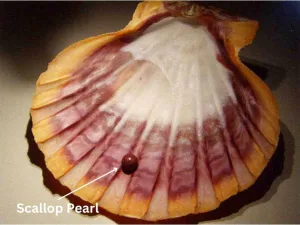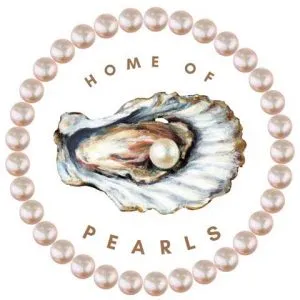Natural pearls are unique gems that is formed without any human intervention. They are created naturally when an irritant, such as a parasite or small piece of shell or sand, enters the mollusk and begins to form layers of nacre around it.
This process can take several years and results in beautiful, one-of-a-kind gems. Natural pearls have been valued for centuries due to their rarity and beauty, making them highly sought after by collectors and jewelry lovers alike.
Even today, natural pearl production is not easy nor inexpensive—making them even more special. Natural pearls come in many shapes and sizes, including round, baroque, drop, and semi-baroque shapes, with varying luster from pearly white to creamy yellow.
Due to their unique shape, natural pearls are often used in vintage jewelry and for creating intricate designs that imitate other gemstones. While man-made cultured pearls have become more available, there is still nothing quite like the beauty of a genuine, one-of-a-kind natural pearl. They truly are the crème de la crème of gems!
Table of Contents
The Persian Gulf
The Persian Gulf is located in the Middle East, bordered by Iran to the north and the Arabian Peninsula to the south. It stretches from the Strait of Hormuz in the northwest to Oman in the southeast and is connected to a number of other waterways through its many intersecting rivers and channels. The Persian Gulf is home to some of the most important oil reserves and ports in the world.
History of pearl fishing in the Gulf
For over 2000 years, the Gulf has been a valuable source of fine pearls. The Gulf has had a chequered history. It was known to the Romans and Tylos’ was their name for Bahrain. In the 16th century, the Portuguese took over the main ports and were noted for their heavy taxes on the pearl-fishing industry for over 100 years.
At Hormuz in the strait during the period of the Portuguese occupation, the treasures of the Orient were gathered to such an extent that it was considered to be the jewel of the center of the world. The fisheries are operated all year round compared to those of Mannar, which are of a shorter period. Diving is restricted to shallower waters during April and May, the deeper waters then being too cold.
The period of June to September is a window in the Gulf when provisioning, buying, selling, and general preparations are made for the pearling season. The oyster which is common to both the Persian Gulf and the Gulf of Mannar is Pinctada radiata, formerly described as Pinctada vulgaris.
Method of pearl fishing in the Gulf
Since the early records were made, little has been recorded in the way of change in the method employed for gathering the oysters. The general method is still that of nude diving.
When the dhows arrive at the fishing grounds, the broad square-bladed oars which they carry are set out at right angles to the sides of the boat to serve as steadying devices and also as bollards for the divers’ ropes.
For each diver, there are two ropes; one has attached to it a heavy stone of about 50 lb in weight and has a loop for the diver’s foot when he is descending; the second rope is attached to a string bag which the diver either carries in his hand or slings around his neck. This bag is for holding any oysters which he may gather, and its rope is for hauling the diver back to the surface.
Prior to descending, the divers put on leather finger stalls to protect their fingers whilst plucking the oysters from the coral reefs or rocks and fixing leather clips to their noses.
Divers do not ‘dive’ in the normal sense, they go feet first, standing on the stone weight, which allows them to step off on reaching the sea-bed. There they gather as many oysters as they can in the short space of time during which their lungs can function without fresh air.
The alertness and assiduity of the rope ‘minders’ left in the boat are tremendously important for the divers’ safety. A sharp tug on the rope signals to the minders to haul them up as fast as possible since most divers stay till the end of their limit. The divers also speed their ascent, when possible, by hauling themselves up the ascending rope.
Recent changes in Pearl fishing in the Gulf
Undoubtedly, oil exploitation has altered the lifestyle of the poorest sections of the communities in this area. Where once divers and crews keenly sought employment in pearling, today, that labor force can find more regular and better pay in the oil industry. It remains to be seen whether or not the damage caused to marine life will accumulate and become permanent and sound the death knell of pearl fishing in the Gulf.
Although there has been a falling-off in pearl production since some of the better-authenticated records were published, rich Arabs still show a strong continuing interest in pearls. In recent years there has been an ever-increasing demand for fully-documented natural pearls of important sizes by pearl merchants with a largely Arab clientele.
The Red Sea
An important source of pearls was the Red Sea, together with the Gulf of Aden, which is its opening into the Indian Ocean, but the area’s importance and products were overshadowed because of its proximity to the Persian Gulf.
Today, as in the case of most of the once-famed sources of pearls, the output from the Red Sea is much diminished. The principal species of oyster fished in this area was Pinctada margaritifera erythraeensis, four to five inches across, similar to the Persian Gulf, found singly and not occurring in banks.
It was fished chiefly for its mother-of-pearl and the occasional pearls found were welcomed as an additional profit. The mother-of-pearl shell is carved in Bethlehem and Jerusalem and, like the Polynesian shell, is a popular product for the tourist industry.
History of pearl harvesting in the Red Sea
The Arab divers of the Red Sea were said to be capable of descending to greater depths than the divers of the Persian Gulf. Fishing in the Red Sea in the more prolific days was done from dhows and small vessels known as ‘sambuks’.
The first fishing season starts in March and finishes at the end of May, followed by a second period in the autumn during September and October.
Natural pearl fishing in the Gulf of Mannar
The Gulf of Mannar is located between India and Sri Lanka, along the southeastern coast. The gulf stretches 180 kilometers in length, with a maximum depth of approximately 3,300 meters. It is home to numerous coral reefs, mangroves, and seagrass beds that provide a habitat for a variety of species.
This region is an ecologically important area as it provides habitats for over 3,600 species of flora and fauna, including sea turtles, dolphins, and whales. Its shallow waters house many fish species, such as snapper, grouper, shark, tuna, and barracuda. The gulf also contains several important fisheries which supply food to local communities.
History of pearl fishing in the Gulf of Mannar (India)
There is no absolute record of the beginning of the pearl-fishing trade in this Gulf, but it probably began well over 2000 years ago. The writings of the early travelers, Arabs, Greeks, and Romans, furnish details in their respective histories of travel.
The pearl fisheries of the Gulf are noted for the quality of their products which have an excellent luster and orient, and undoubtedly the fisheries conducted in earlier times were instrumental in attracting foreign merchants to the area.
When the Portuguese arrived in southern India around the middle of the 16th century, they Christianized and afforded protection to the local population of Paravas against the threat of the Mohammedans, who were becoming proficient divers.
The Paravas enjoyed near-monopolistic rights due to their tribute payments to the monarch of the time. The Portuguese also assumed control of the fishing.
In 1658 the Dutch took over from the Portuguese until, in 1796, control passed to Great Britain. This situation lasted until Great Britain relinquished its role over India in 1947, since when pearl fishing became a State monopoly.
Australia
Pearl fishing started in Australia about 1861 and is thus comparatively new in comparison with that of the Red Sea, the Persian Gulf, and the Gulf of Mannar. The fisheries extend from Cooktown on the northeast coast to Fremantle on the southwest coast.
Like many of the pearl discoveries, there appeared at first to be inexhaustible supplies of shells, whether for mother-of-pearl or pearls, or both. Three types of oysters are fished around the Australian coast, namely Pinctada maxima, Pinctada margaritifera and Pinctada carchariarum.
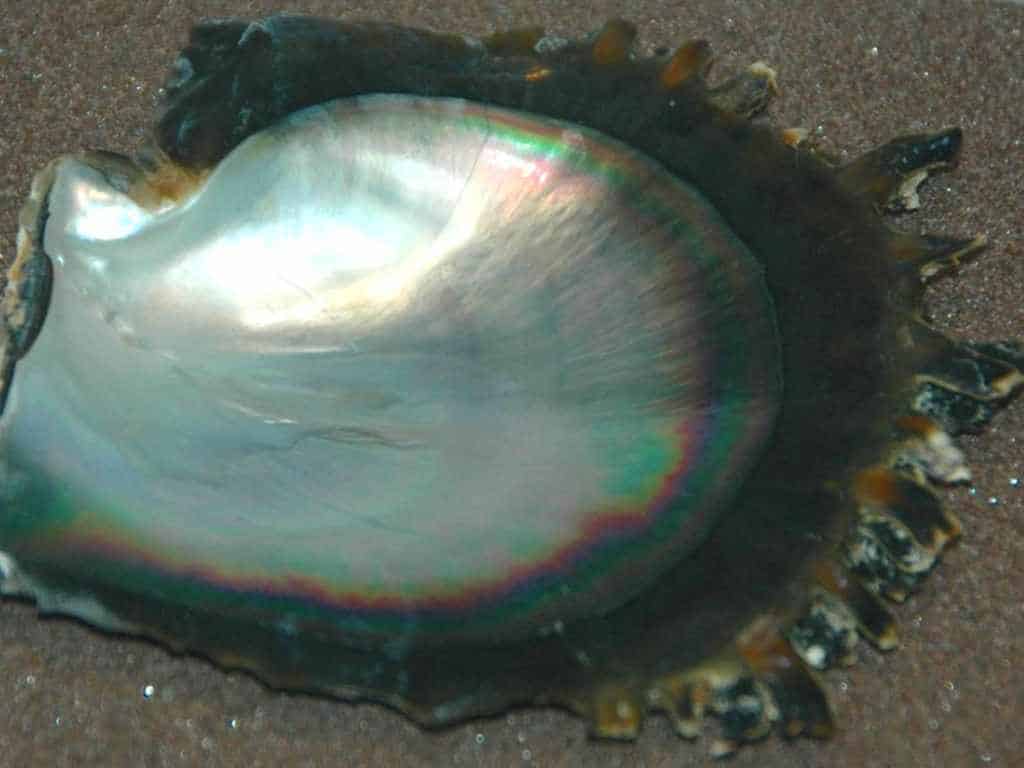
The largest of the trio, P. maxima, grows in Australian waters up to 12 in in diameter with a weight of approximately 121b, and it was widest in distribution over the whole area. Originally it was sought for its mother-of-pearl content, pearls being a secondary bonus.
Its shell is uniformly white and known as a ‘silver-lip’ shell. It does not occur in densely populated beds but rather in a scattered manner on rocky reefs which extend for miles.
Some ‘gold-lip’ shell is found in muddier conditions in narrow channels between islands of the northwest coast. P. margaritifera is a smaller oyster, seldom measuring more than 8 in diameter, with a weight of around 21b; it is distinctive by reason of a black edge around the interior perimeter of the shell and is termed ‘black-lip’.
It is not so plentiful as P. maxima, but it is to be found thinly scattered around the Queensland and Western Australia coasts to just below Shark Bay.
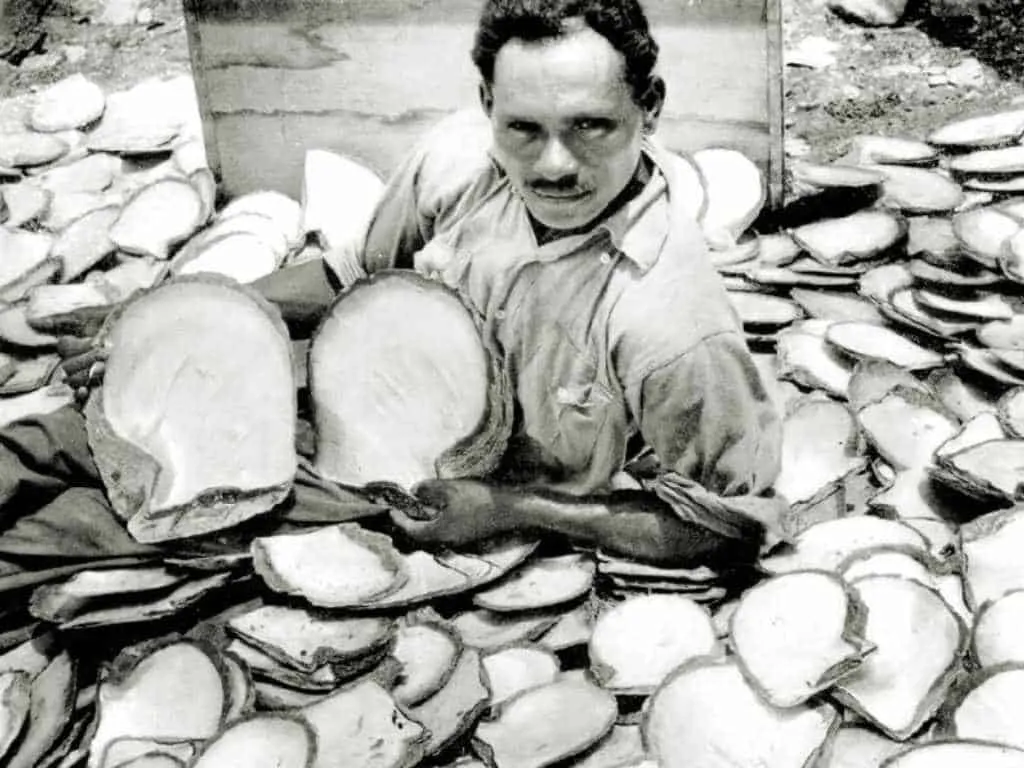
The various colors of ‘silver,’ ‘gold’, and ‘black’ applied to the mantle are probably due to protein in the food supply. Trace elements also can cause coloring. P. carchariarum, the smallest of Australia’s pearl oysters, is similar in size to the P. radiata of the Persian Gulf and is confined almost entirely to the Shark Bay area of Western Australia.
The shell lost its commercial importance for button-making in competition with the Mississippi shell. The pearls found in this relatively small oyster are of shades of yellow straw and occasionally a fine golden color.
